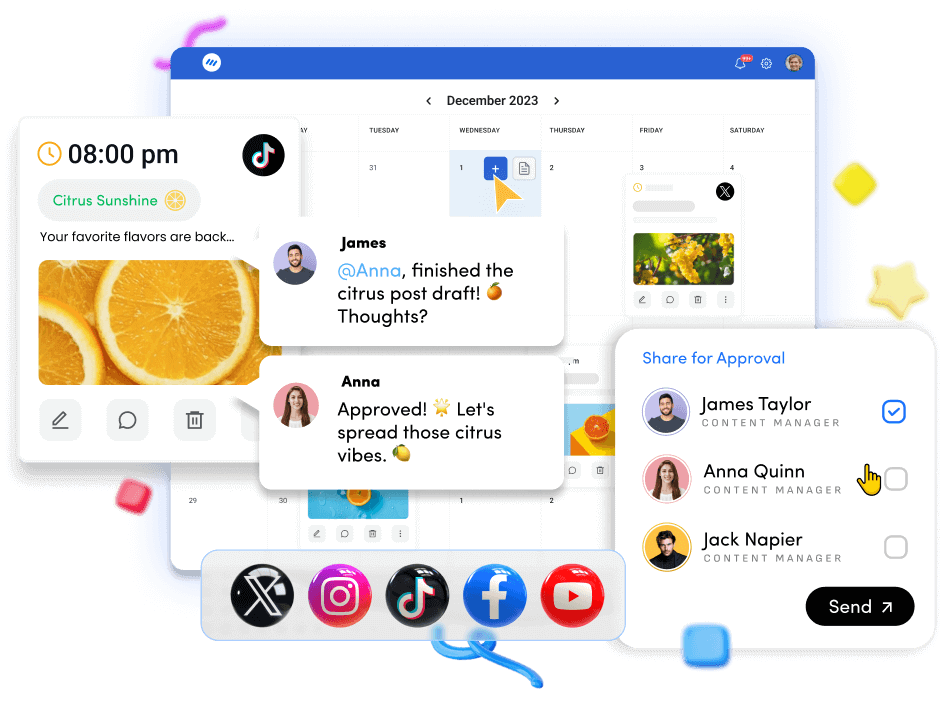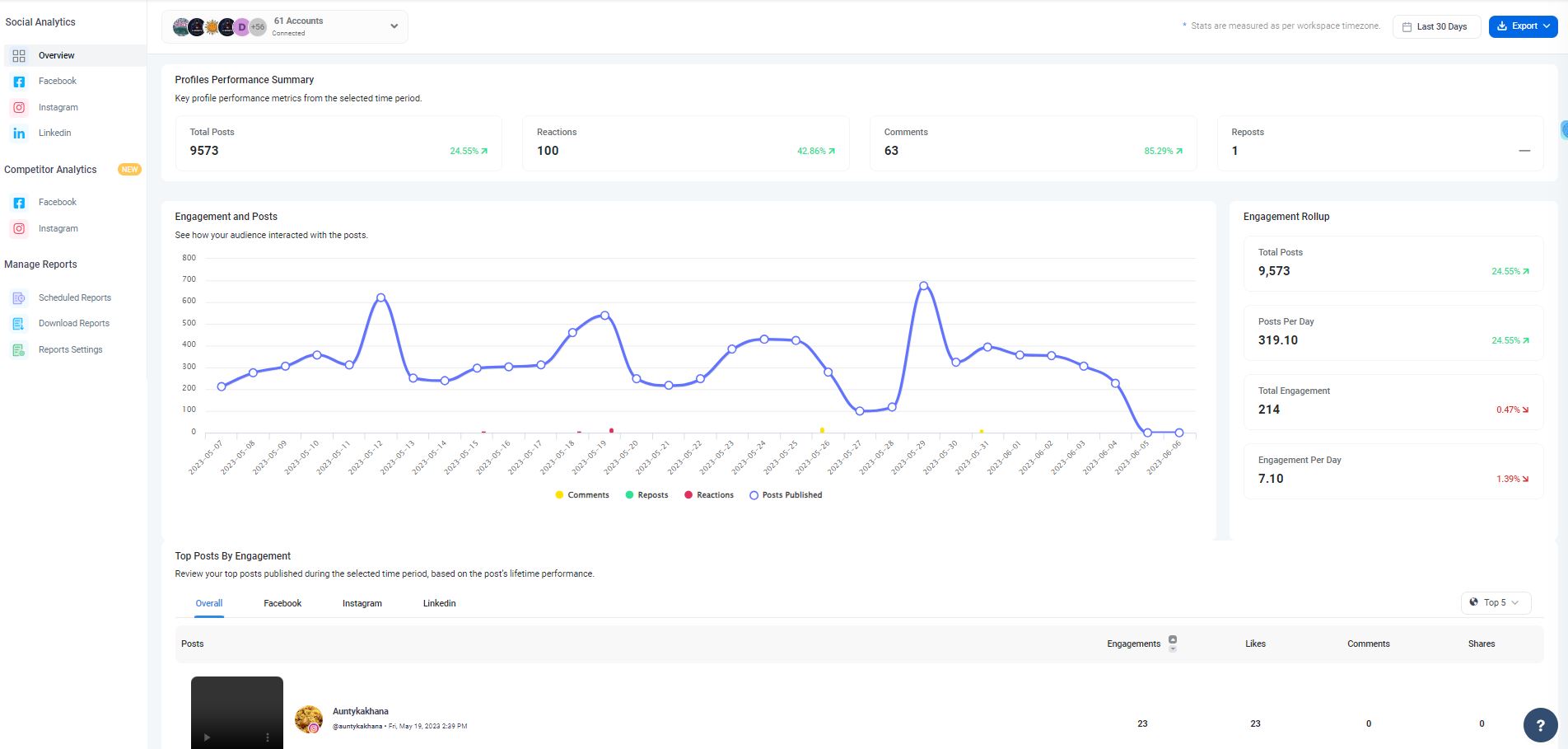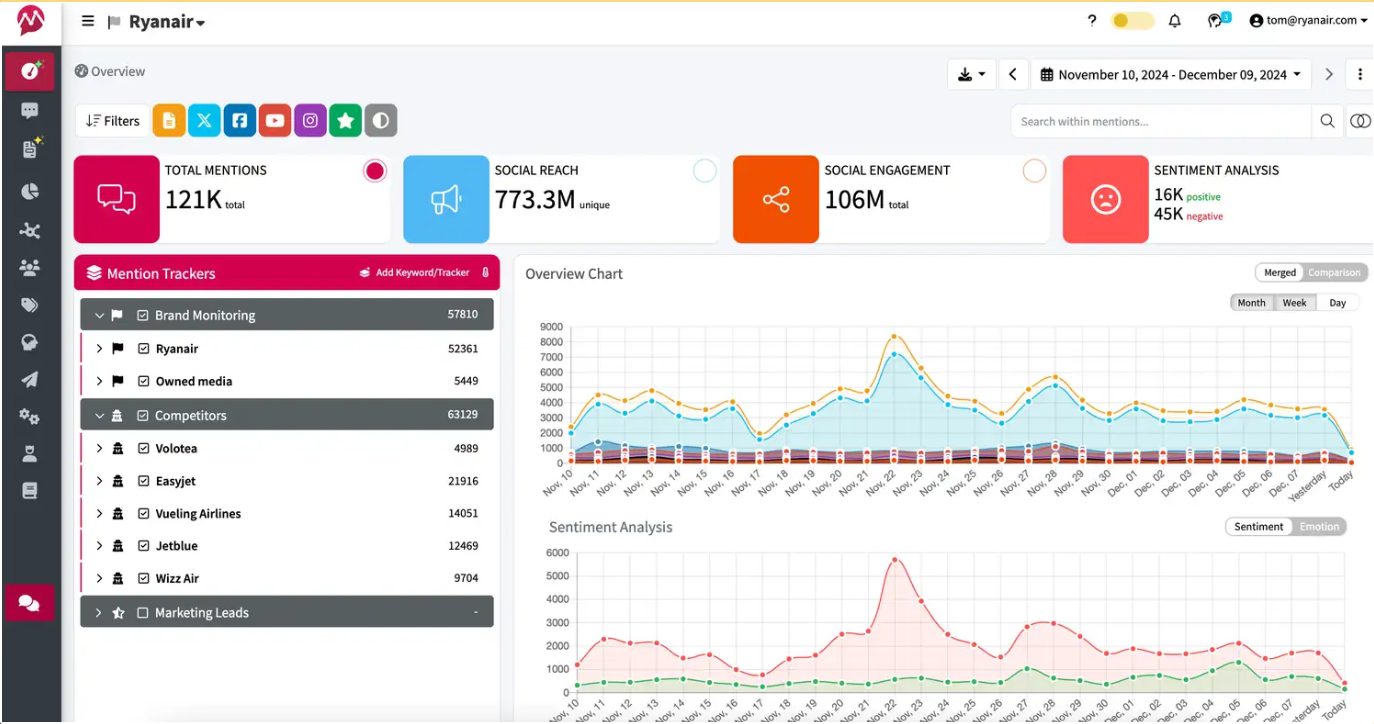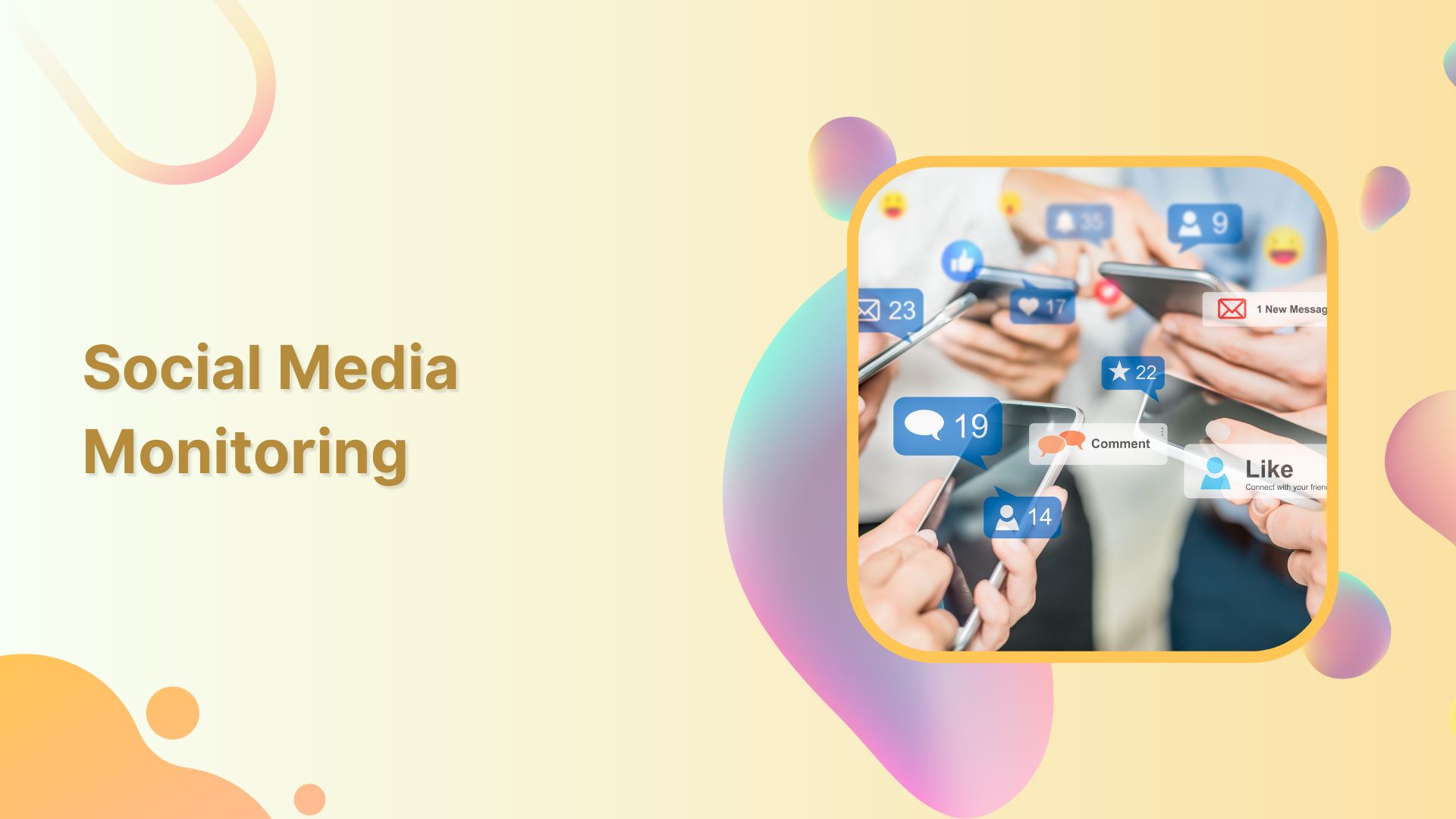In today’s hyper-connected world, brand conversations are a 24/7 phenomenon. Where tweets go viral in an instant, and Instagram stories capture attention like never before.
How can you, as a social media manager or marketer, navigate an ever-changing landscape with millions of conversations taking place every day?
The answer is a robust social media monitoring strategy. This blog will unveil why such a strategy is essential for modern social media branding.
It’s time to move beyond essential engagement; let’s delve into the world of proactive social media monitoring that will help you turn social chatter into actionable insights for your brand.
What is social media monitoring?

Social media monitoring, sometimes also referred to as listening, involves identifying and assessing what is being said about a company, individual, product, or brand across different social media platforms.
It involves tracking digital conversations to understand the sentiments and attitudes towards your brand. This goes beyond just tallying likes, comments, and shares. It includes analyzing mentions, hashtags, keywords, trends about your brand & monitor your scheduled content on Twitter, Facebook, Instagram, LinkedIn, Google my business etc.
It is like having a crystal ball that reveals how the world sees your brand. You get a sense of how the audience is feeling, understanding their cheers, jeers, needs, and deeds. It empowers you to respond to the waves of love, anger, or questions that impact your brand’s reputation.
What’s more?
It’s a powerful treasure map, pointing you towards insights that can shape your marketing campaigns, enhance your online reputation, uncover industry trends, reveal competition tactics, and discover customer leads.
The easiest way to manage and grow your social channels.

Why is social media monitoring necessary?
In the digital age, where every like, comment, and share carries significant weight, brands that embrace social media monitoring gain a competitive edge and navigate the social media landscape with confidence.
Let’s explore the reasons why social media monitoring is necessary for brands.
-
Reputation management
Nowadays a brand’s reputation is its most valuable asset. Social media monitoring allows brands to proactively manage their reputation by keeping a tab on what customers and the wider public are saying about them.
For example, when United Airlines faced a passenger removal crisis, social media monitoring enabled the company to track and respond to the overwhelming public backlash. By swiftly addressing the situation, providing transparent updates, and taking necessary actions, United Airlines aimed to mitigate the damage to its reputation.

-
Crisis detection and response
Social media monitoring tools act as a powerful early warning system, alerting brands to potential crises in real time. By monitoring keywords, brand mentions, and sentiment, brands can detect emerging issues and respond promptly.
For example, social media monitoring helped Samsung identify and address customer concerns, initiate a product recall, and reassure the public about its commitment to safety when it faced a crisis with its Galaxy Note 7 smartphones exploding.

-
Understanding your audience
Social media monitoring provides insights into the needs, wants, preferences, and behaviours of customers. Brands can analyze conversations, sentiment trends, and feedback to gain a more deeper understanding of their target audience. This isn’t about intrusive surveillance but understanding the kind of content they engage with, the influencers they follow, and the discussions they partake in.
For instance, Netflix utilizes social media monitoring tools to gather insights about viewer preferences, which helps them make data-driven decisions in content creation and acquisition. By understanding their audience’s tastes and interests, they can deliver personalized recommendations and engage customers in meaningful ways.

-
Competitor analysis
Social media monitoring allows brands to keep a close eye on their social media competitors and identify opportunities for differentiation. By monitoring competitor activities, content, and customer interactions, brands can gain insights into their competitors’ strategies and gauge market sentiment.
For example, Coca-Cola monitors social media to understand how consumers respond to their competitor Pepsi’s campaigns. This knowledge helps Coca-Cola refine its marketing strategies and stay ahead in the highly competitive beverage industry.

Social Media Analytics Fine-tune your social media strategy for success with in-depth analytics and white-labeled reports.
-
Influencer identification and partnerships
Social media monitoring tools help brands identify influential voices in their industry and forge partnerships for mutual benefit. By monitoring social media platforms, brands can find relevant influencers who align with their values and target audience.
For example, when Adidas recently collaborated with the popular celebrity Jenna Ortega to create buzz and reach a wider audience. Through accurate monitoring, Adidas identified the right influencers to amplify their brand message and increase product visibility.

-
Campaign evaluation and optimization
Social media monitoring provides real-time feedback on the performance of marketing campaigns. Brands can track engagement metrics, sentiment analysis, and customer feedback to assess the impact of their campaigns and make data-driven decisions for optimization.
For instance, Taco Bell utilizes social media monitoring tools to evaluate the success of its campaigns. By analyzing social media conversations and sentiment, they can gauge customer response and tailor their future marketing efforts to resonate with their target audience.

How to set up social media monitoring?
Setting up social media monitoring is a strategic process that involves careful planning, selection of tools, and implementation of effective monitoring strategies. Here are the essential steps to guide you in establishing an efficient monitoring system:
-
Step 1: Define your objectives
Start by clearly defining your social media monitoring goals. Determine what you want to achieve with monitoring. Are you primarily focused on brand reputation management, customer sentiment analysis, competitor analysis, or all of the above? Establishing clear objectives will help you tailor your monitoring efforts accordingly.

-
Step 2: Select the right tools
Choose the appropriate social media tools that align with your objectives and budget. There are various tools available, ranging from free monitoring options like Google Alerts and TweetDeck to more comprehensive paid platforms such as Content Studio, Hootsuite, Brandwatch, or Sprout Social. Consider factors like data accuracy, real-time monitoring capabilities, sentiment analysis, and user-friendly interfaces when evaluating different tools.
-
Step 3: Identify relevant keywords and topics
Determine the keywords, hashtags, and topics you want to monitor. These should be specific to your brand, industry, products, or any relevant conversations. For instance, if you’re a fashion retailer, you might track keywords like “fashion trends,” “clothing brands,” or even your brand name. Think about the terms your audience uses when discussing related topics and incorporate them into your monitoring strategy.

-
Step 4: Set up monitoring dashboards
Configure your monitoring tool to create custom dashboards that display relevant metrics and data. This will help you track and analyze KPIs effectively. Customize your dashboards to display information such as mentions, sentiment analysis, engagement levels, and demographic data. Having a centralized dashboard streamlines the monitoring process and enables you to gain valuable insights at a glance.

-
Step 5: Establish alerts and notifications
Set up alerts and notifications to receive real-time updates when specific keywords or mentions are detected. This ensures that you’re promptly informed about important conversations, potential crises, or customer feedback that requires immediate attention. These alerts could be in the form of email notifications, SMS alerts, or push notifications within your monitoring tool.

-
Step 6: Monitor and analyze conversations
Regularly monitor social media platforms for conversations about your brand, industry, or chosen keywords. Track mentions, comments, and sentiments to gauge public opinion and identify emerging trends. Pay attention to both positive & negative feedback, as they provide insights for improving your products, services, or customer experiences.

-
Step 7: Engage with your audience
Social media monitoring isn’t just about listening; it’s about engaging with your audience. Respond to customer inquiries, address concerns, and thank customers for the positive feedback. Engaging with your audience fosters authenticity, builds trust, & strengthens the connection between your brand and customers. Utilize the insights gained from monitoring to tailor your responses and provide personalized interactions.

-
Step 8: Analyze and refine your strategy
Regularly analyze the data and insights gathered from your monitoring efforts. Identify patterns, trends, and opportunities for improvement. Assess how well your social media campaigns are performing, customer service efforts, and overall brand perception. Use these insights to refine your social media strategy, content creation, and customer engagement initiatives.
Top 10 Social Media Monitoring Tools
Below is a list of the top ten social media monitoring tools.
-
ContentStudio

ContentStudio is a social media management platform with content discovery and content curation features.
It allows users to plan their content, collaborate, and publish their posts across multiple channels from a single dashboard.
Furthermore, its social media monitoring capabilities help users track brand mentions and relevant conversations online, making it a comprehensive tool for managing a brand voice.
Here are the key monitoring features of ContentStudio:
- Provides content insights, competitor analytics and performance metrics.
- Robust content scheduling and curation.
- Effective Team Collaboration and streamlined approval workflow.
ContentStudio offers 3 different pricing plans. The Starter plan is $25/month for individuals and solo marketers, the Pro plan is $49/month for small teams and SMBs, and the Agency plan is $99/month for large teams and digital agencies.
-
Hootsuite

Hootsuite is a comprehensive social media management platform that allows you to monitor multiple social media platforms from a centralized dashboard.
With real-time analytics, scheduling capabilities, and content curation tools, Hootsuite is a go-to choice for managing your social media presence.
Its top features include:
- Real-time analytics and performance metrics.
- Content scheduling and curation for efficient social media management.
- Collaboration tools to streamline team workflows.
Hootsuite’s pricing plans start at just $99 per month for its Professional plan, $249 per month for its Team plan, $739 per month for its Business plan, and pricing for its Enterprise plan is available upon request.
-
Brandwatch

Brandwatch is a powerful social media listening tool that provides deep insights into brand mentions, customer sentiments, and industry trends.
Its advanced sentiment analysis, competitor benchmarking, and customizable dashboards give you a competitive edge in understanding your audience.
Key features include:
- Advanced sentiment analysis for understanding customer opinions.
- Competitor benchmarking to stay ahead of the competition.
- Customizable dashboards for tailored reporting and analysis.
Its pricing is available on request.
-
Mentionlytics

Mentionlytics is an intelligent social media monitoring tool that keeps track of your online presence on all major social channels and the entire web. With AI-powered sentiment analysis, customizable dashboards, and real-time alerts, the platform collects and analyzes mentions of your brand, competitors, and any keywords to safeguard your online reputation.
Key features include:
- AI sentiment analysis to get a deeper understanding of your audience
- Customizable dashboards and reports to tailor insights to your needs
- Real-time alerts by SIA, the AI Social Intelligence Advisor that detects spikes in mentions to prevent crises and gives personalized tips to improve strategies.
Its pricing plans start at $69 per month for its Basic plan, $139 per month for its Essential plan, $249 per month for its Advanced plan, $399 per month for its Pro plan, $599 per month for its Agency plan, and $950 per month for its Enterprise plan.
-
Sprout Social

Sprout Social offers a user-friendly interface and a suite of robust features for social media monitoring and management.
With real-time engagement tracking, sentiment analysis, and comprehensive social media reporting, Sprout Social equips you with the tools to build meaningful connections with your audience.
Notable features include:
- Real-time engagement tracking to connect with your audience promptly.
- Sentiment analysis for understanding customer perceptions.
- Detailed social media reporting for measuring campaign effectiveness.
Its pricing plans start at just $249 per month for its Standard plan, $399 per month for its Professional plan, $499 per month for its Advanced plan, and pricing for its Enterprise plan is available upon request.
-
Brand24

Brand24 is a social media monitoring tool that helps track brand mentions, analyze sentiment, and identify influencers.
With real-time alerts, sentiment analysis, competitor analysis, and customizable reports, Brand24 empowers you to stay on top of your brand’s online reputation.
Noteworthy features include:
- Real-time alerts for immediate response to brand conversations.
- Competitor analysis for staying ahead in the market.
- Customizable reports for insightful data visualization.
Its pricing plans start at just $79 per month for its Individual plan, $149 per month for its Team plan, $199 per month for its Pro plan, and $399 per month for its Enterprise plan.
-
Talkwalker

It is an AI-powered social media analytics platform that provides comprehensive insights into brand reputation, customer sentiment, and industry trends.
Its social media listening capabilities, image recognition technology, crisis management tools, and influencer identification features give you a holistic view of your brand’s online presence.
Notable features include:
- Social media listening to capture real-time conversations.
- Image recognition technology for monitoring visual content.
- Crisis management tools for proactive brand protection.
Its pricing is available upon request.
-
Mention

Mention is a real-time social media monitoring tool that tracks brand mentions across various online platforms, including social media, news sites, and blogs.
With sentiment analysis, competitive analysis, and customizable alerts, Mention ensures you never miss a conversation about your brand.
Key features comprise:
- Customizable alerts to stay informed about brand conversations.
- Sentiment analysis for gauging customer opinions.
- Competitive analysis to identify industry trends and key players.
Mention’s pricing plans start at just $41 per month for its Solo plan, $83 per month for its Pro plan, and $149 per month for its Pro plus plan.
-
Awario

Awario is a social media monitoring tool which offers real-time tracking of brand mentions, sentiment analysis, and competitive intelligence.
With Boolean search, influencer tracking, social media listening, and customizable reports, Awario enables you to uncover actionable insights about your brand’s online presence.
Its top features include:
- Real-time tracking of brand mentions across various platforms.
- Sentiment analysis for understanding customer opinions.
- Influencer tracking to identify key industry influencers.
Its pricing plans start at just $24 per month for its Starter plan, $74 per month for its Pro plan, and $249 per month for its Enterprise plan.
-
Brandmentions

A social media monitoring tool that revolutionizes online presence management. Brandmentions offers real-time monitoring, sentiment analysis, and competitor tracking.
Its top features include:
- Real-time Monitoring with instant notifications whenever your brand is mentioned across various platforms.
- Sentiment Analysis to gain a deep understanding of customer sentiment to adapt your strategies effectively.
- Competitor Tracking to keep a close eye on your competitors’ activities and brand mentions to identify areas for improvement.
Its pricing plans start at just $99 per month for its Growing Business plan, $299 per month for its Company plan, and $499 per month for its Enterprise/Agency plan.
-
Meltwater

Meltwater is a media intelligence platform that offers social media monitoring, media tracking, and PR analytics.
With social media listening, brand sentiment analysis, media coverage tracking, and competitor benchmarking features, Meltwater equips you with the tools for making data-driven decisions and build a strong online presence.
Notable features include:
- Social media listening to capture brand mentions and customer sentiments.
- Brand sentiment analysis for understanding brand perception.
- Competitor benchmarking for staying ahead of the competition.
Its pricing is available upon request.
5 tips for effective social media monitoring
In order to help you navigate the domain of social media monitoring like a pro, here are five tips for effective monitoring:
- Monitor multiple platforms: Don’t limit yourself to a single social media platform. Monitor multiple platforms like Facebook, Twitter, Instagram, LinkedIn, and even niche platforms that are relevant to your industry. Each platform offers unique insights and engagement opportunities

- Stay updated with social media trends: Internet is constantly evolving, and it’s crucial to stay up-to-date with the latest social media trends, features, and best practices. Keep an eye on industry blogs, attend webinars, and participate in relevant discussions to ensure that your social media monitoring efforts are always informed and effective.

- Monitor competitor activities: Keep a close eye on your competitors and track their social media activities. Analyze their content, engagement strategies, and customer interactions. This allows you to gain insights into their tactics, identify gaps in the market, and make informed decisions to differentiate your brand.

- Analyze data and extract insights: Regularly analyze the data gathered from social media monitoring to extract valuable insights. Look for patterns, trends, and opportunities for improvement. Analyzing data helps you understand audience preferences, identify emerging trends, and optimize your social media strategies accordingly.

- Monitor beyond brand mentions: Effective social media monitoring goes beyond tracking brand mentions. Expand your monitoring scope to include industry social media trends, competitor activities, and relevant keywords. By keeping tabs on broader conversations, you can identify emerging trends, understand customer preferences, and stay ahead of the competition.
Turn social media noise into notes with ContentStudio
In the bustling world of social media, listening can be just as important as speaking. Social media monitoring equips brands with the tools needed to understand their audience, manage their reputation, and stay competitive. It’s not just about tracking numbers—it’s about transforming conversations into actionable insights.
Want to transform the social media chatter into a melody of progress? Explore ContentStudio’s social media monitoring feature. It’s your all-in-one toolkit to manage your brand’s online narrative, identify trends, and harness the power of digital dialogues. Don’t just be part of the conversation, command it.
FAQs
How can social media monitoring inform your sales and product teams?
Social media monitoring informs sales and product teams by providing valuable insights into customer feedback, sentiment analysis, market research, and competitor analysis. It helps identify customer needs, improve products, and refine sales strategies.
How does social media monitoring work?
Social media monitoring works by tracking and analyzing online conversations, mentions, and engagements related to a brand or product. It involves using specialized tools to monitor multiple social media platforms, news sites, blogs, and forums to gather data and insights for businesses.
What is the difference between social media listening & monitoring?
While social media monitoring and listening are related, there is a subtle difference. It involves tracking and analyzing specific mentions and conversations about a brand or product. Social media listening is a broader approach that involves monitoring and understanding customer sentiments, industry trends, and market insights to inform overall business strategies. Listening goes beyond individual mentions to gain a holistic understanding of the social media landscape.
